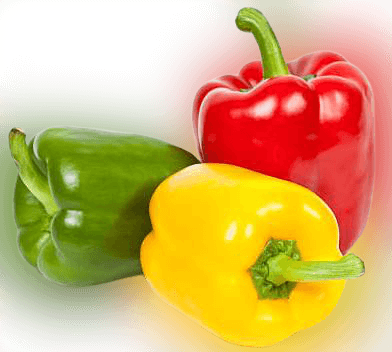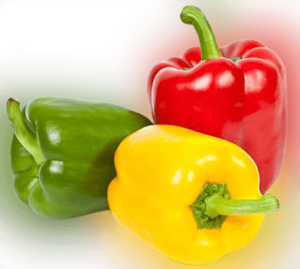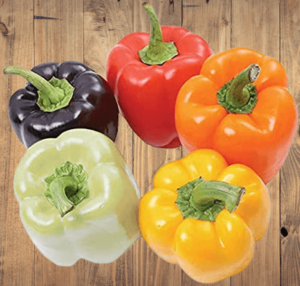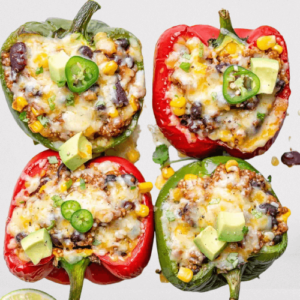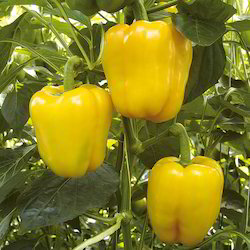Bell peppers or Capsicum
Overview:
Bell peppers are commonly known as sweet peppers and capsicum. The Fruits of plants in the group of species: Capsicum annuum and belongs to the nightshade family. Bell peppers are native to Mexico, Central America and North-South America. Cultivated in Spain in 1493 then spread through Europe and Asia. These peppers are known in different countries with different names, such as Bell peppers (US, Canada, Philippines), Sweet pepper (UK, Ireland), and Capsicum (Australia, Bangladesh, India, Malaysia, New Zealand, Pakistan and Sri Lanka). Bell peppers are dried and powdered which is known as paprika. Bell peppers are low in calories and rich in vitamin C and antioxidants which are very healthy. The bell pepper plant bears fruit in a variety of colors including red, yellow, orange, green, white and purple. Bell peppers taste slightly bitter when unripe and has a sweet taste when fully ripe.
Nutrition:
The main nutrients in 100 grams of raw bell pepper are 39 calories, 1.5 grams of protein, 9 grams of carbohydrates, 2.5 grams of fiber, 3.5 grams of sugar and 0.5 grams of fat. Moreover, red bell pepper is an excellent source of Vitamin A, Vitamin B, Vitamin C, Vitamin E, Sodium and Potassium.
Carbs
Bell peppers are composed primarily of water and carbs. Bell peppers contain slightly fewer carbohydrates and more calories. 100 grams contains 9 grams of carbohydrates. The carbohydrates in red bell peppers are mostly sugars – such as glucose and fructose, both of which naturally taste sweet. Bell pepper is a good source of fiber, which contains 2.5 grams of fiber per 100 grams.
Vitamins and minerals and Health Benefits
Bell peppers are rich in vitamins and minerals.
Vitamin C
Vitamin C, which contains known antioxidants. This antioxidant is one of the sources of nutrition and provides various health benefits. Protects human cells from oxidative damage, can prevent iron deficiency anemia, folate absorption provides benefits for healthy bones, skin and hair.
Vitamin B6
Vitamin B6, commonly known as pyridoxine, Which needed for the body to stay healthy. It is essential for processes such as brain development and the transport of oxygen through the bloodstream. It helps maintain the nervous and immune systems.
Vitamin K1
Vitamin K1, also called phylloquinone, is essential for reducing inflammation, blood clotting and bone metabolism. The presence of phylloquinone in the blood indicates diabetes and other risk factors for cardiovascular disease.
Vitamin E
The powerful antioxidants in vitamin E boost the body’s resistance to infection and protect cells from damage. Vitamin E is essential for healthy skin, healthy nerves, eyesight and muscle.
Vitamin A
Vitamin A, which helps maintain normal vision, works for immunity and reproduction. It helps Healthy growth, the heart, lungs, kidneys and other organs to function properly. Vitamin A can reduce the risk of cancer.
Potassium
Potassium in bell peppers is one of the most important minerals in the body. Potassium lowers blood pressure and keeps the heart healthy, helping regulate muscle contractions and nerve signals. Even protects against stroke and prevents kidney stones.
Carotenoid
Carotenoids in red bell peppers contain especially lutein and zeaxanthin. Adequate eating of which improves eye health. Protects the retina from oxidative damage.
Bell peppers recipes or Capsicum recipes or Sweet pepper recipes
Stuffed bell peppers recipe or stuffed capsicum recipe, Roasted red peppers, Vegetarian stuffed peppers, Keto stuffed peppers, Roasted red peppers soup, Vegan stuffed peppers, Mexican stuffed peppers, Stuffed peppers casserole, Green peppers recipes, Best healthy stuffed peppers recipe , Stuffed peppers with ground beef, Instant pot stuffed peppers, Easy stuffed peppers, Vegetarian stuffed peppers recipe, Italian stuffed peppers, Stuffed pepper soup recipe, Chicken stuffed peppers, Stuffed green peppers recipe, Turkey stuffed peppers, Philly cheesesteak stuffed peppers, Taco stuffed peppers, Roasted bell peppers, Ground turkey stuffed peppers, Best healthy stuffed capsicum recipe, Stuffed red peppers, Red bell peppers recipes, Keto stuffed bell peppers, Green bell peppers soup, Buffalo chicken stuffed peppers, Low carb stuffed peppers, Stuffed green peppers soup, roasting peppers, Bell pepper soup, Sausage stuffed peppers, Stuffed peppers in oven, Easy stuffed bell peppers, Vegetarian stuffed bell peppers, Red peppers soup recipe, Cheesesteak stuffed peppers, Stuffed sweet peppers, Old fashioned stuffed bell peppers recipe, Stuffed bell peppers soup, Stuffed peppers with mince, Classic stuffed peppers, Stuffed peppers instant pot, Costco stuffed peppers, Skinnytaste stuffed peppers, Turkey stuffed bell peppers, Bell pepper salad, Stuffed bell peppers without rice, Southern stuffed bell peppers, Stuffed green peppers with rice, Betty crocker stuffed peppers, Bell pepper nachos, Stuffed peppers keto, Healthy stuffed bell peppers, Stuffed peppers recipe easy, Stuffed bell peppers with rice, Grilled stuffed peppers, Deconstructed stuffed peppers, Stuffed peppers in crock pot, Green bell pepper recipes, Red bell peppers recipes, Instant pot stuffed pepper soup, Vegan stuffed bell peppers, Vegetarian stuffed capsicum, Stuffed peppers with uncooked rice and ground beef, Chicken stuffed bell peppers, Grilled bell peppers, Unstuffed pepper casserole, Bell peppers and cream cheese, Bell peppers keto, Bell peppers pizza, Bell peppers cream cheese, Pickled bell peppers, Ground chicken stuffed peppers, Mexican stuffed peppers recipe, Stuffed peppers air fryer, Stuffed peppers with cheese, Quinoa stuffed bell peppers, Pioneer woman stuffed peppers, Stuffed peppers with rice and cheese, Roasted red peppers recipe, Stuffed peppers with quinoa, Stuffed peppers with ground beef and rice, Stuffed pepper casserole recipe, Lasagna stuffed peppers, Stuffed bell peppers keto, Stuffed bell pepper casserole.
How to start bell peppers growing
Bell peppers production requires warm soil and warm temperature. However, the temperature is an important factor for bell peppers plant growth. So healthy bell pepper plant should be produced in late summer.
Soil warming is required for seeds to germinate. Care of the bell peppers plant in the early stages is important. The soil temperature should not be too hot at just 65 ° F. Beneficial soil bacteria can be killed if the temperature is high. When the weather warms up the young plants grow to about 8 inches (20 cm) tall, plant them in the garden. Where there is full sunlight and well-drained soil whose pH (6.5 – 7.00) is neutral. Keep the soil evenly moist to produce improved fruit. Too wet or too dry soil will reduce plant health and fruit development.
It is especially important to water 1 to 1 1/2 inches continuously every week when the plants are flowering and bearing fruit. Bell peppers will not bear much fruit if the temperature is not normally between 70 and 90 degrees Fahrenheit. Fertilizers should not be given in large quantities especially with nitrogen. It increases leaf greenness, but it usually interferes with flower and fruit production. Bell peppers fruits are 3 to 4 inches (7.6 to 10 cm) long and ready to be harvested after the fruit is hard and green.
